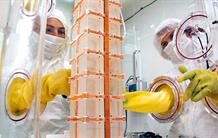After four years of study, the Luminescent Underground Molybdenum Investigation for Neutrino mass and nature (LUMINEU) collaboration has selected lithium molybdate for the manufacture of scintillating bolometers. These ultrasensitive particle detectors will be used for neutrinoless double-beta-decay searches. Should evidence of the latter be highlighted, neutrinos would merge with their antiparticle and the absolute mass of the neutrino would become accessible.
In Gran Sasso, Italy, under 1400 meters of rocks, the international detector CUORE detectors (Cryogenic Underground Observatory for rare Events) has begun its long watch. One thousand bolometers containing 741 kg of tellurium dioxide (TeO2) cooled to 10 millikelvins are waiting to record the very rare radioactive decay of tellurium 130—this time not just a double-beta decay (emission of two electrons and two anti-neutrinos) but the even rarer, neutrinoless double-beta decay.
To increase the probability of detecting this event, the researchers at LUMINEU propose using "scintillating" bolometers, capable of measuring not only the very slight excess of heat that's a signature of radioactive decay, but also the light emission that it induces in the crystal. The latter acts as the emitter and detector at the same time. This innovative concept drastically reduces the surrounding radioactive background while preserving the exceptional energy resolution and efficiency of bolometers. Another essential point is picking the best nucleus among ten candidates: 100Mo.
Two crystals of approximately 200 g of Li2100MoO4 were produced and tested, one at the Modane Underground Laboratory (LSM), and the other at the Gran Sasso underground laboratory. According to this study, 200 kg of enriched crystals and a ten-year exposure should lead to a tenfold sensitivity increase on the absolute mass of the neutrino, compared to current experiments.
Beginning in November 2017, scintillating bolometers at LSM combined with twenty 210 g crystals will accumulate data for over a year. This demonstrator will provide the best global result on the double-beta decay of 100Mo, leading to the final choice of the crystal to be used in detector CUPID (Cuore Upgrade with Particle Identification), CUORE's successor.
Contact : Claudia Nones




